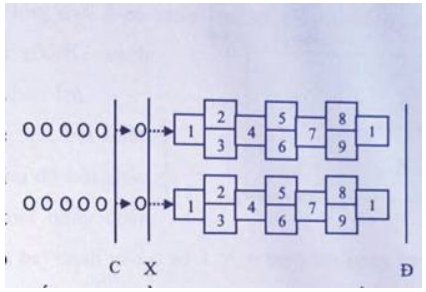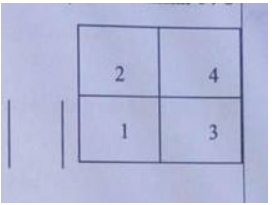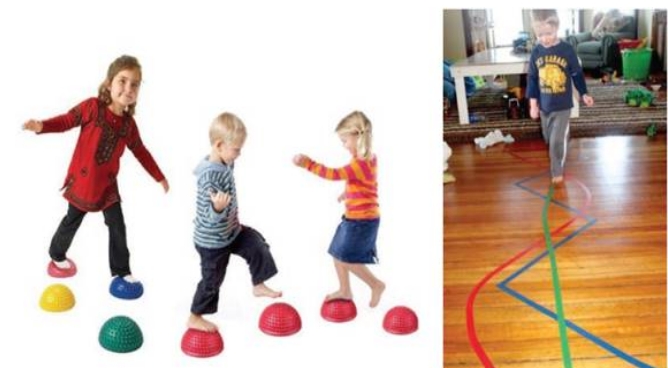Guidelines for Some Physical Exercises to Enhance Fitness for Primary School Students in Vietnam
Guidelines for Some Physical Exercises to Enhance Fitness for Primary School Students in Vietnam
According to Appendix 3 issued together with Decision 2195/QD-BGDDT in 2022, here are some instructions for physical exercises to enhance fitness for primary students as follows:
(1). Game: RELAY BALL PASSING
* Purpose:
- To train students' concentration, reflexes, agility, and dexterity;
- To develop a sense of teamwork discipline during the game.
* Content and gameplay:
- Prepare 2-4 rubber or plastic balls.
- Assemble students into 2-4 vertical lines with equal numbers of participants. The first student in each line holds a ball with both hands raised above their head.
- Upon command, the first player in line 1 turns to the left and passes the ball to their teammate behind them. This continues in the same manner until the last player in line. The last player then passes the ball to the right to the player in front of them, and the ball moves up the line to the first player. Once the ball reaches the first player, they raise the ball and shout, "Reporting... finished." This determines which team was the fastest. If any player drops the ball during the relay, they must quickly pick it up and continue.
- Infractions: passing the ball out of order.
* Utilization:
- Based on the game's purpose and the lesson's content, it can be used as a warm-up exercise or a dexterity-building activity suitable for physical education instruction.
- This game can be used in extracurricular activities, afterschool programs, or team-building exercises to enrich content and improve activity effectiveness, fostering a sense of discipline and teamwork during play and learning.
(2). Game: SAWING
* Purpose:
- To develop upper body strength, coordination, and dexterity;
- To instill teamwork and discipline during the activity.
* Content and gameplay:
- Assemble into 2-4 horizontal lines, facing each other in pairs, separated by a line. Stand with one foot forward, one back, and grasp each other’s wrists.
- Gameplay: At the teacher's command, students chant:
"Sawing, sawing,Sawing as hard as we can,
Smoothly and rhythmically,
Expanding our chests,
Strengthening our limbs,
Heave-ho! Heave-ho!"
When chanting "Heave-ho!", students pull their partners towards them. The student who successfully pulls their partner wins.
* Utilization:
- Use the game as a warm-up exercise or a strength and dexterity activity suitable for physical education.
- This game can enhance extracurricular activities, improve the effectiveness of team exercises, and foster discipline and community spirit among students.
(3). Game: HOPSCOTCH RELAY
* Purpose:
- To strengthen jumping skills, leg power, and agility;
- To foster teamwork and discipline during the activity.
* Content and gameplay:
- Assemble students into 2 vertical lines. Upon command, the first students jump with both feet into square 1, then into squares 2 and 3, and finally into square 4, before running back to the starting line to tag the next player. The process continues until all players complete the course. The fastest team with the fewest infractions wins.
* Utilization:
- Based on the game's purpose and the lesson content, it can be used as a physical education activity.
- This game can be used in extracurricular activities, enhancing content richness, fostering discipline, teamwork, and encouraging mutual support among students.

(4). Game: JUMPING CORRECTLY AND QUICKLY
* Purpose:
- To improve jumping skills, leg strength, and agility;
- To foster discipline and teamwork during the activity.
* Content and gameplay:
- Preparation: Draw two large squares (each with 1m sides) divided into four smaller 0.5m squares and number them. Draw preparation and starting lines 1m apart.
- Gameplay: Each player in turn jumps with both feet into square 1, then left foot into square 2, right foot into square 3 and both feet into square 4, then jumps out. The next player starts when the first finishes, and the fastest team with the fewest infractions wins.

* Utilization:
- Use as a warm-up exercise or an agility and leg strength development activity suitable for physical education.
- This game enhances extracurricular activities, improves activity effectiveness, fosters discipline, teamwork, and encourages mutual support among students.
(5). Game: SHUTTLECOCK KICKING
* Purpose:
- To improve dexterity, accuracy, and hand strength;
- To foster discipline and teamwork during the activity.
* Content and gameplay:
- Preparation: Form a circle or horizontal lines. Students stand 1.5m apart. Each student with a shuttlecock.
- Gameplay:
• Option 1: Each student stands in place or moves while using hands, small boards, or table tennis paddles to keep the shuttlecock airborne.
• Option 2: Paired students keep the shuttlecock off the ground.
• Option 3: Compete to see who can keep the shuttlecock in the air the longest or the fastest within 1 minute.
* Utilization:
- Use as a strength and dexterity development activity suited for physical education.
- This game enhances extracurricular activities, fostering discipline, teamwork, and encouraging mutual support among students.
(6). Game: RELAY RUNNING
* Purpose:
- To develop running skills, speed, and coordination within a team;
- To foster discipline and teamwork during the activity.
* Content and gameplay:
- Preparation: Draw starting and finishing lines 6-8m apart. Assemble students into 2-4 vertical lines with equal numbers behind the starting line.
- Gameplay: At the command, the first students run to the finish line, circle back, and return to tag the next player, continuing until all players finish. The fastest team with the fewest infractions wins.
- Infractions:
• Starting before the command or tagging improperly.
• Not circling the marker.
* Utilization:
- Use as a skill-building and coordination exercise suitable for group activities.
- This game enhances extracurricular activities, fostering discipline, teamwork, and encouraging mutual support among students.
(7). Game: CATCH THE DUCKLING
* Purpose:
- To develop agility, quickness, and coordinated movement.
- To foster discipline during the activity.
* Content and gameplay:
- Gameplay: The teacher draws a large circle for children to stand inside as ducklings.
- Select 3-5 children to be duck herders outside the circle.
- When the herder calls "duck, duck, duck" and waves, the ducklings get out of the circle and approach the herder.
- Upon the signal "Catch the duckling," the herders chase the ducklings. Ducklings must quickly return to the circle (the pond) while quacking "duck, duck, duck…"
- If a duckling is tagged, they are caught and must sit out for one round. The game continues with different players assuming roles as needed.
- Rules: Ducklings can only be tagged outside the circle. Tagged players are considered caught.
(8). Game: CARS AND SPARROWS
* Purpose:
- To develop reflexes, focus, and coordinated movement.
- To foster discipline during the activity.
* Content and gameplay:
- The teacher prepares one or two small circles with a 20cm diameter. Designate the playing area in the middle of the yard, drawing lanes for cars and sidewalks.
- The teacher simulates driving a "car" with a ring, while students act as "sparrows."
- The sparrows hop around "eating grain" on the road, occasionally bending down to peck.
- Hearing the car's "honk honk" (bim bim), sparrows must quickly hop off the road onto the sidewalk.
- After the car passes, sparrows return to the road to hop and peck. Once students become familiar with the game, select two nimble students to play as "cars."
- Rules: Upon hearing "honk honk," students must quickly move off the road.
- Attention: Teachers should alert students with loud honks and approach slowly to avoid confusion. Remind children not to push each other during the game.
- For excitement, introduce the car (with honks) every 30 seconds.
(9). Game: BALANCE WALKING
* Purpose:
- To develop coordination and balance.
- To foster discipline during the activity.
* Content and gameplay:
- Preparation: Use colored tape or balance beams. Draw start and finish lines (10-15m apart).
- In between, create paths with different colored tapes or balance beams. - Gameplay: Students form vertical lines in teams of 3-5. Players compete by walking the line or balance beam. The next player can start once the previous player finishes. The team whose last member finishes first wins.
- Gameplay: Students form vertical lines in teams of 3-5. Players compete by walking the line or balance beam. The next player can start once the previous player finishes. The team whose last member finishes first wins.
(10). Game: HORSE RACING
* Purpose:
- To develop reflexes, imitation skills, and coordinated movement.
- To foster discipline during the activity.
* Content and gameplay:
- Gameplay: Students form 2-3 teams. The teacher says, "Let's pretend to be horses. We're going to race. Remember to mimic horse gallops by lifting your legs high. The fastest and most accurate horse wins."
- Students run approximately 20m and return. Three students per team compete; the team with the most fast horses wins.
Guidelines for Some Physical Exercises to Enhance Fitness for Primary School Students in Vietnam (Image from the Internet)
What is physical activity for primary students in Vietnam?
According to subsection 1.1.1, section 2, part 1 of the guidelines for organizing school meals combined with enhancing physical activity for children and students in preschool and primary educational institutions issued together with Decision 2195/QD-BGDDT in 2022, physical activity is defined as follows:
Physical activity is any bodily movement produced by muscles and bones that increases heart rate, respiration, and energy expenditure during execution.
Physical activities may include everyday tasks, playful activities, physical exercise, and commuting.
For children and students, physical activities include sports and recreational games, physical education, school sports, activities during breaks, walking, running, cycling to school, and extracurricular activities like excursions and sports training.
What are the physical activity recommendations for primary school students?
According to subsection 1.1.3, section 2, part 1 of the guidelines for organizing school meals combined with enhancing physical activity for children and students in preschool and primary educational institutions issued together with Decision 2195/QD-BGDDT in 2022, the physical activity recommendations are as follows:
According to the World Health Organization's recommendations, children should be encouraged to engage in physical activities for at least 60 minutes per day, which can be divided into multiple sessions of at least 10 minutes each, combining moderate and vigorous activities appropriate for their age, gender, and developmental stages.

